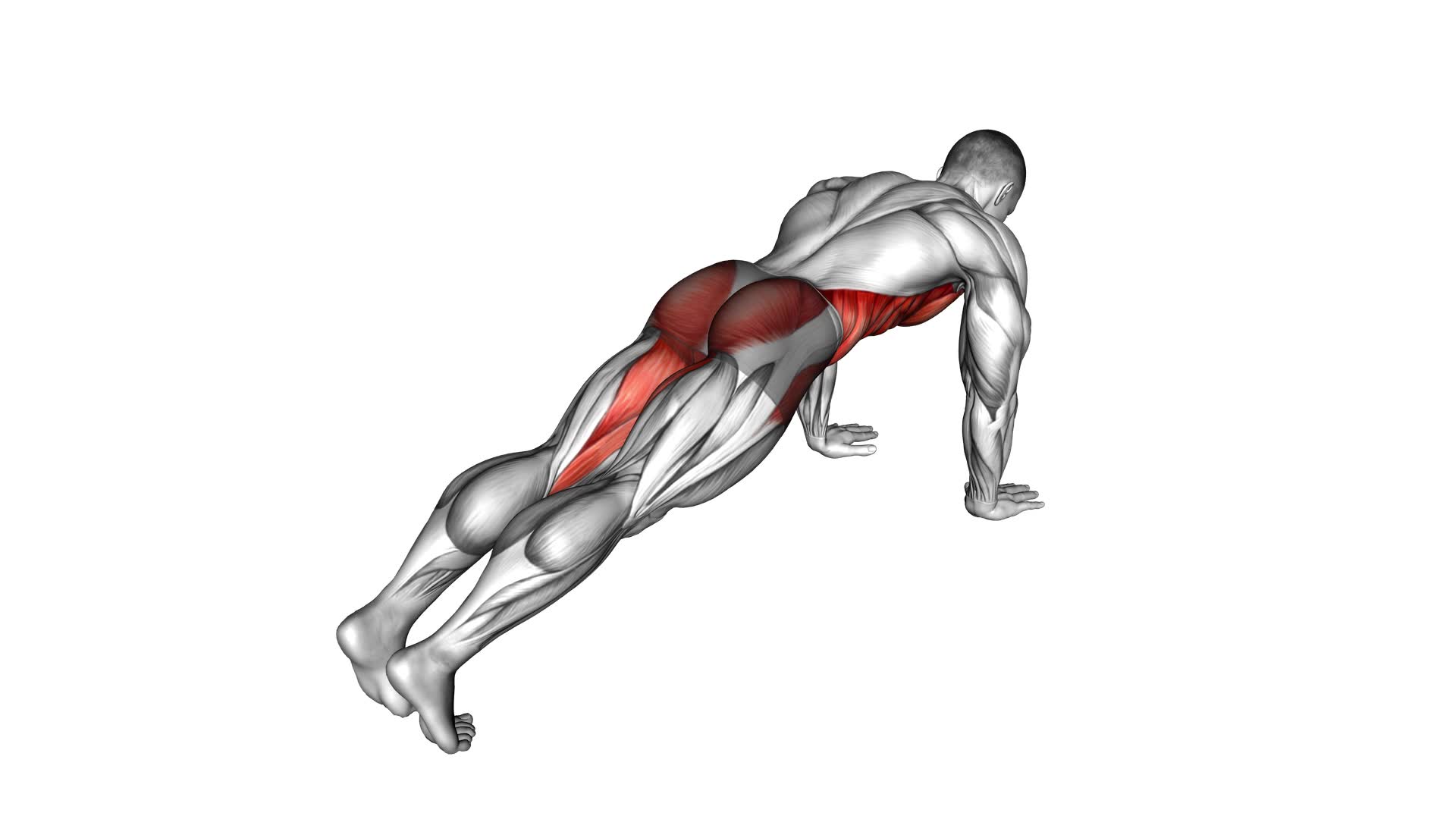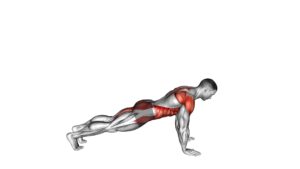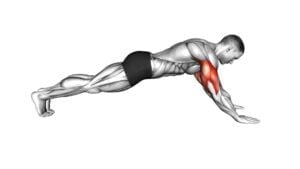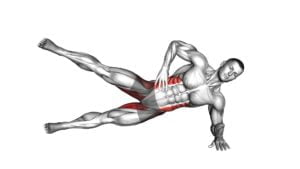Leg Extension Plank – Video Exercise Guide & Tips

Are you looking to strengthen your core and tone your legs? The leg extension plank is the perfect exercise for you.
Watch This Exercise Video
In this video exercise guide, we'll show you the proper form and technique, as well as provide modifications for different fitness levels.
Avoid common mistakes and maximize your workout with our helpful tips. Get ready to feel the burn and achieve your fitness goals with the leg extension plank.
Let's get started!
Key Takeaways
- Leg Extension Plank strengthens the core and tones the legs.
- It engages abdominal muscles, glutes, quadriceps, and hip flexors.
- The exercise improves overall strength, balance, and coordination.
- Common mistakes to avoid include sagging lower back, holding breath, and raising hips too high.
Benefits of Leg Extension Plank
To maximize your core strength and stability, perform the Leg Extension Plank for a minimum of 30 seconds. This exercise is highly effective in activating your muscles and improving your core strength.
The Leg Extension Plank primarily targets your abdominal muscles, including the rectus abdominis, transverse abdominis, and obliques. By engaging these muscles, you can develop a strong and stable core, which is essential for maintaining proper posture and preventing lower back pain.
During the Leg Extension Plank, your core muscles work to stabilize your body in a straight line, while your legs extend out behind you. This plank variation not only targets your core, but also engages your glutes, quadriceps, and hip flexors. By activating these muscle groups, you can improve your overall strength and muscular endurance.
In addition to building core strength, the Leg Extension Plank also helps to improve your balance and coordination. As you hold the plank position and extend your legs, you must engage your core muscles to maintain stability. This exercise can also enhance your overall body control and stability, making it beneficial for athletes and individuals involved in sports or other physical activities.
Proper Form and Technique
Maintain proper form and technique while performing the Leg Extension Plank to ensure optimal results and minimize the risk of injury. Here are some key points to keep in mind:
- Common misconceptions: One common mistake is allowing your hips to sag or lift too high. To maintain a straight line from your head to your heels, engage your core muscles and squeeze your glutes. Another misconception is holding your breath. Remember to breathe steadily throughout the exercise to maintain proper oxygen flow.
- Variations: Once you have mastered the basic Leg Extension Plank, you can challenge yourself by adding variations. Try lifting one leg off the ground or adding a knee tuck by bringing your knee towards your chest. These variations can target different muscle groups and increase the intensity of the exercise.
- Progressions: As you become stronger, you can progress to more advanced variations. For example, you can try performing the Leg Extension Plank on an unstable surface, such as a balance board or a stability ball. This will further engage your core muscles and improve your balance.
By maintaining proper form and technique, avoiding common misconceptions, and exploring variations and progressions, you can maximize the benefits of the Leg Extension Plank.
Now, let's move on to discussing modifications for different fitness levels.
Modifications for Different Fitness Levels
As you progress in your fitness journey, you can modify the Leg Extension Plank to accommodate different fitness levels. There are several progression options you can try to challenge yourself and continue making progress.
One option is to increase the duration of the plank. Start with holding the plank for 30 seconds and gradually work your way up to a minute or even longer.
Another progression option is to add resistance by using ankle weights or a resistance band. This will increase the intensity of the exercise and engage your muscles even more.
If you find the standard Leg Extension Plank too challenging, there are equipment variations you can consider. Instead of performing the exercise on the floor, you can use an exercise ball. Place your feet on the ball instead of the floor and perform the plank in this position. This will provide additional instability and require more core strength to maintain balance.
Another option is to use a stability disc or a Bosu ball. These tools will add an extra challenge by requiring you to stabilize your body while performing the plank.
Common Mistakes to Avoid
As you progress in your fitness journey and modify the Leg Extension Plank to accommodate different fitness levels, it's important to be aware of common mistakes to avoid. These common errors can hinder your progress and even lead to injury. Here are some mistakes to watch out for:
- Allowing your lower back to sag: This is a common mistake that puts unnecessary stress on your lower back. To avoid this, engage your core muscles and maintain a straight line from your head to your heels.
- Holding your breath: It's important to breathe properly during the Leg Extension Plank to maintain stability and provide oxygen to your muscles. Remember to inhale and exhale slowly and steadily throughout the exercise.
- Raising your hips too high: While it may seem like raising your hips higher will make the exercise more challenging, it actually shifts the focus away from your core muscles. Keep your hips in line with your shoulders to ensure proper engagement of your abdominal muscles.
By avoiding these common mistakes, you'll be able to perform the Leg Extension Plank more effectively and maximize the benefits of the exercise.
Now, let's move on to some tips to maximize your workout and take your fitness journey to the next level.
Tips to Maximize Your Workout
To maximize your workout, it's important to focus on proper form techniques. This means maintaining a straight body alignment and engaging your core muscles throughout the exercise.
Additionally, targeting specific muscle groups by adjusting your body position can help you get the most out of each repetition.
Lastly, be mindful of the duration of your workout, as finding the optimal balance between intensity and rest is key for achieving your fitness goals.
Proper Form Techniques
To maximize your workout, ensure proper form by maintaining a stable plank position throughout the leg extension exercise. Here are some tips to help you achieve the correct form and get the most out of this exercise:
- Common misconceptions: One common misconception is that you need to lift your legs too high. In reality, the goal is to keep your legs parallel to the ground, engaging your core and glutes.
- Variations: To challenge yourself, you can try performing the leg extension plank on an unstable surface like a stability ball or a Bosu ball. This will further engage your core muscles.
- Progressions: Once you have mastered the basic leg extension plank, you can progress by adding ankle weights or resistance bands to increase the difficulty and further strengthen your legs and core.
Targeted Muscle Engagement
Engaging your core and glutes is key to maximizing the effectiveness of the leg extension plank exercise. To ensure proper muscle activation, focus on tightening your abdominal muscles and squeezing your glutes throughout the entire exercise. This will help stabilize your body and prevent any unnecessary movement.
Additionally, variations of the leg extension plank can target different muscle groups to provide a well-rounded workout. For example, lifting one leg off the ground while maintaining the plank position will increase the activation of your glutes and hamstrings. Alternatively, adding a knee tuck by bringing your knee towards your chest will engage your lower abs even more.
Optimal Workout Duration
Maximize your workout by focusing on the optimal duration for the leg extension plank exercise. To achieve maximum workout intensity and make the most of your time, consider the following tips:
- Start with shorter durations: Begin by holding the leg extension plank for 20-30 seconds. This allows you to build strength gradually and avoid overexertion.
- Increase duration gradually: As your strength improves, aim to extend the duration of the exercise. Add 5-10 seconds to your plank time every week to keep challenging your muscles.
- Listen to your body: Pay attention to how your body feels during the exercise. If you experience discomfort or pain, reduce the duration or take a break. It's important to prioritize safety and avoid injury.
Recommended Sets and Reps
For optimal results, aim to perform the Leg Extension Plank exercise for three sets of 10 to 12 repetitions. This recommended set and rep scheme will help you effectively target and engage your core muscles while also improving your overall strength and stability.
When performing the Leg Extension Plank, it's important to maintain proper form throughout each repetition. Keep your body in a straight line from head to toe, engaging your core muscles to stabilize your body. Avoid arching or rounding your back, as this can lead to strain or injury.
If you find the exercise too challenging, you can modify it by performing it on your knees instead of your toes. This will decrease the difficulty level and allow you to focus on building strength and stability in your core.
Common mistakes to avoid when performing the Leg Extension Plank include sagging your hips or lifting your hips too high. Aim to maintain a straight line from your head to your heels throughout the exercise.
Incorporating the Leg Extension Plank into your workout routine can be a great way to strengthen your core and improve your overall stability. Aim to perform this exercise for three sets of 10 to 12 repetitions, and remember to focus on maintaining proper form and engaging your core muscles throughout each repetition.
Frequently Asked Questions
How Many Calories Does the Leg Extension Plank Exercise Burn?
The leg extension plank exercise is a great way to burn calories and reap the benefits of a strong core. By engaging your abdominal muscles and holding your body in a straight line, you can torch calories and improve your overall fitness.
This exercise targets multiple muscle groups, helping you to burn more calories in less time. Incorporating leg extension planks into your workout routine can be an effective way to increase calorie burn and strengthen your core.
Can Leg Extension Plank Help in Reducing Lower Back Pain?
The leg extension plank can help reduce lower back pain. By engaging your core muscles and stabilizing your spine, this exercise strengthens the muscles that support your lower back.
Additionally, the leg extension plank has various variations that target different muscle groups, providing overall body strength and stability. Adding these variations to your workout routine can't only help alleviate lower back pain but also improve your overall strength and posture.
Is It Safe to Perform Leg Extension Plank if I Have a Knee Injury?
If you have a knee injury, it may not be safe to perform the leg extension plank. It's important to prioritize your knee's healing process and avoid exercises that could potentially worsen the injury.
However, if your knee is healthy, the leg extension plank can be effective for weight loss and can help improve balance and stability.
Always consult with a healthcare professional to determine what exercises are safe for your specific condition.
Can Leg Extension Plank Help in Strengthening the Core Muscles?
Leg extension plank is an effective exercise for strengthening core muscles. By incorporating plank variations, like leg extensions, you can target not only your abs but also your lower back, obliques, and glutes.
This exercise challenges your stability and engages multiple muscle groups simultaneously, helping you build a stronger core. However, it's important to ensure proper form and technique to avoid any potential injury, especially if you have a knee injury.
What Are Some Alternative Exercises to the Leg Extension Plank for Targeting the Same Muscle Groups?
Looking for alternative exercises to target the same muscle groups as the leg extension plank?
There are a few options you can try.
One option is the traditional plank, which also works the core muscles.
Another option is the mountain climber exercise, which engages the abs, back, and shoulders.
Lastly, the Russian twist is a great exercise for targeting the obliques.
Give these alternatives a try to keep your workouts fresh and challenging.
Conclusion
In conclusion, the leg extension plank is a highly effective exercise for strengthening the core and legs. By maintaining proper form and technique, you can maximize the benefits of this exercise and avoid common mistakes.
Additionally, modifying the exercise to suit your fitness level and following the recommended sets and reps will help you achieve the desired results.
Remember to incorporate these tips into your workout routine for an efficient and effective workout.

Author
Years ago, the spark of my life’s passion ignited in my mind the moment I stepped into the local gym for the first time. The inaugural bead of perspiration, the initial endeavor, the very first surge of endorphins, and a sense of pride that washed over me post-workout marked the beginning of my deep-seated interest in strength sports, fitness, and sports nutrition. This very curiosity blossomed rapidly into a profound fascination, propelling me to earn a Master’s degree in Physical Education from the Academy of Physical Education in Krakow, followed by a Sports Manager diploma from the Jagiellonian University. My journey of growth led me to gain more specialized qualifications, such as being a certified personal trainer with a focus on sports dietetics, a lifeguard, and an instructor for wellness and corrective gymnastics. Theoretical knowledge paired seamlessly with practical experience, reinforcing my belief that the transformation of individuals under my guidance was also a reflection of my personal growth. This belief holds true even today. Each day, I strive to push the boundaries and explore new realms. These realms gently elevate me to greater heights. The unique combination of passion for my field and the continuous quest for growth fuels my drive to break new ground.







